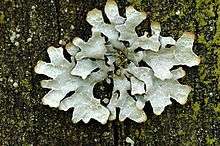Parmelia (fungus)
Parmelia is a genus of medium to large foliose lichens.[2]:78 The ends of the leaf-like lobes are often squarish-tipped.[2]:78 The upper surface is pale bluish-gray to light brown in direct sunlight, with a network web-like ridges and depressions.:78 The lower surface is black and has rhizines anchoring it to the substrate.[2]:78
| Parmelia | |
|---|---|
 | |
| Parmelia sulcata | |
| Scientific classification | |
| Kingdom: | Fungi |
| Division: | Ascomycota |
| Class: | Lecanoromycetes |
| Order: | Lecanorales |
| Family: | Parmeliaceae |
| Genus: | Parmelia Ach. (1803) |
| Type species | |
| Parmelia saxatilis | |
| Species[1] | |
|
See text. | |
It has a global distribution, extending from the Arctic[3] to the Antarctic continent[4][5] but concentrated in temperate regions.[6] There are about 40 species in Parmelia.[7] It is a foliaceous lichen, resembling a leaf in shape. In recent years, the genus Parmelia has been divided into a number of smaller genera according to thallus morphology.
Description and ecology
In general, Parmelia have a dark lower side with rhizines ('rootlets') which attach the lichen to its substrate. The upper side may be several colours - grey, yellow, brown - and may have reproductive organs on it. These may be apothecia (spore producing bodies), isidia or soralia (both vegetative structures). In between these two layers is the medulla which contains the algal component of the lichen.
Parmelia lichens are food for the caterpillars of certain Lepidoptera, such as the bagworm moth Taleporia tubulosa.
Species
- Parmelia asiatica
- Parmelia adaugescens
- Parmelia barrenoae
- Parmelia cochleata
- Parmelia collenma
- Parmelia discordans
- Parmelia encryptata
- Parmelia ernstiae
- Parmelia erumpens
- Parmelia fertilis
- Parmelia fraudans
- Parmelia homogenes
- Parmelia hygrophila
- Parmelia imbricaria
- Parmelia lindmanii
- Parmelia marmariza
- Parmelia martinicana
- Parmelia mayi
- Parmelia omphalodes
- Parmelia pinnatifida
- Parmelia praesquarrosa
- Parmelia pseudolaevior
- Parmelia pseudotenuirima
- Parmelia saxatilis – salted shield lichen
- Parmelia serrana
- Parmelia shinanoana
- Parmelia skultii
- Parmelia squarrosa − bottlebrush shield lichen
- Parmelia subdivaricata
- Parmelia submontana
- Parmelia subtestacea
- Parmelia sulcata − hammered shield lichen
- Parmelia sulymae
- Parmelia tenuirima
- Parmelia tiliacea
References
- "Parmelia" (HTML). NCBI taxonomy. Bethesda, MD: National Center for Biotechnology Information. Retrieved 1 July 2018.
- Field Guide to California Lichens, Stephen Sharnoff, Yale University Press, 2014, ISBN 978-0-300-19500-2
- Skult H (1985) A New Subspecies of Parmelia omphalodes Ascomycetes Described from the Arctic. Annales Botanici Fennici 22, 201-6.
- D.C. Lindsay (1973) Notes on Antarctic lichens: IV. The genera Cetraria Hoffm., Hypogymnia (Nyl.) Nyl., Menegazzia Massal, Parmelia Ach. and Platismatia Culb. et Culb. British Antarctic Survey Bulletin 36, 105-114.
- J. Hooker (1847) The Botany of the Antarctic voyage. Vol. 1. Flora Antarctica. Part 2 Botany of Fuegia, the Falklands, Kerguelens land, etc. Reeve Bros., London.
- Bisby, Guy Richard; Ainsworth, G. C.; Kirk, P. M.; Aptroot, André (2001). Ainsworth & Bisby's Dictionary of the fungi / by P. M. Kirk... [et al.]; with the assistance of A. Aptroot... [et al.] Oxon: CAB International. p. 378. ISBN 978-0-85199-377-5.
- Ossowska, Emilia; Guzow-Krzemińska, Beata; Kolanowska, Marta; Szczepańska, Katarzyna; Kukwa, Martin (2019). "Morphology and secondary chemistry in species recognition of Parmelia omphalodes group – evidence from molecular data with notes on the ecological niche modelling and genetic variability of photobionts". MycoKeys. 61: 39–74. doi:10.3897/mycokeys.61.38175.